Corporate Law Assignment ACC2006/ACC204 Group 2017
VerifiedAdded on 2020/05/11
|8
|1755
|75
Homework Assignment
AI Summary
This assignment solution addresses two key questions related to Australian corporate law. The first question examines potential breaches of the Corporations Act 2001 by company directors, focusing on duties of care and diligence, the business judgment rule, and the misuse of position and information. The analysis draws on relevant case law, including ASIC v Vizard and ASIC v Macdonald, to determine whether breaches occurred and whether defenses are applicable. The second question focuses on shareholder remedies under the Corporations Act, specifically addressing oppressive conduct. It analyzes whether a minority shareholder, Tom, has grounds to seek remedies based on the actions of the majority shareholders, referencing cases like Thomas v H W Thomas Ltd and Hillam v Ample Source International Ltd. The solution concludes with a bibliography of the resources used, including legislation, cases, articles and journals.

Paraphrase This Document
Need a fresh take? Get an instant paraphrase of this document with our AI Paraphraser
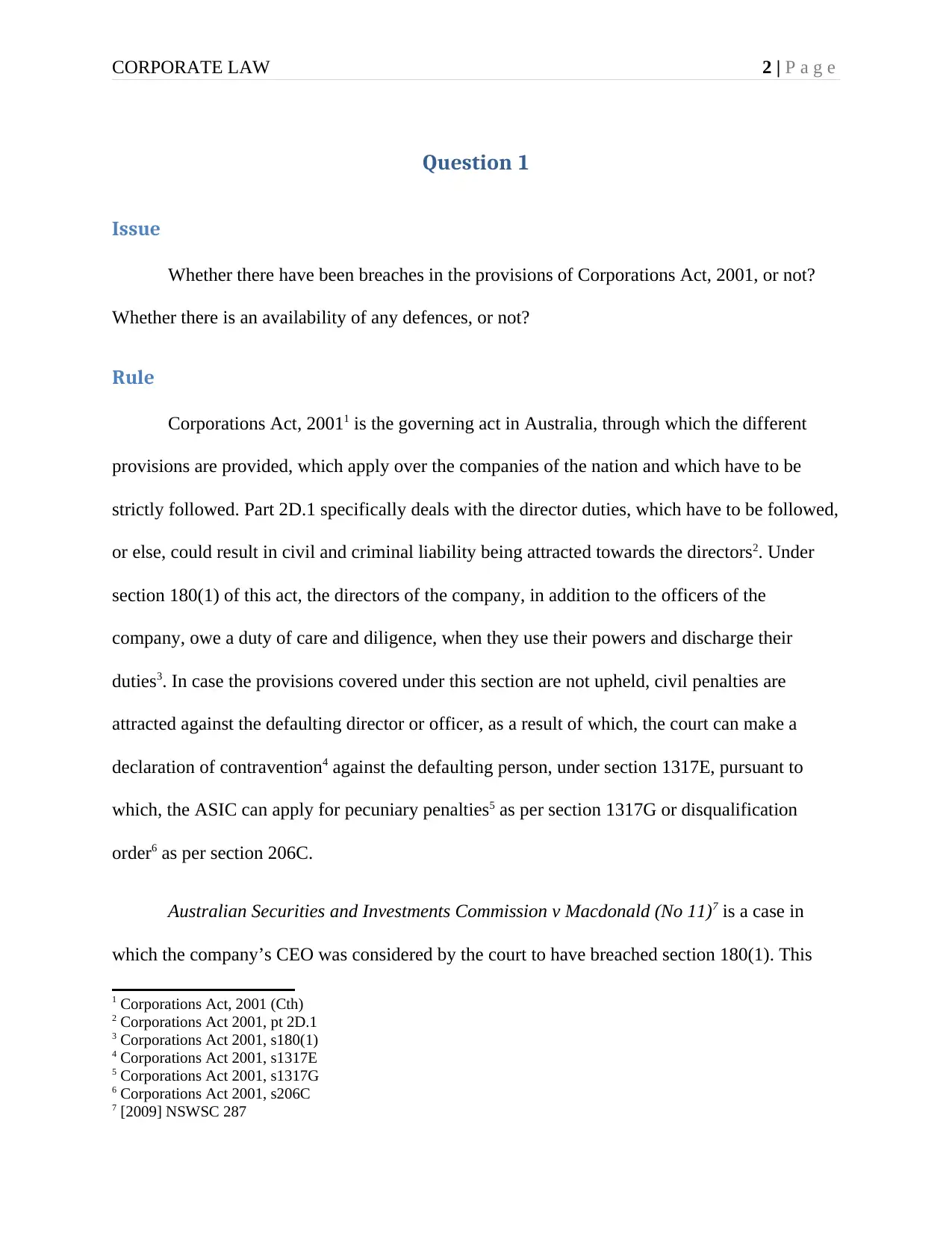
CORPORATE LAW 2 | P a g e
Question 1
Issue
Whether there have been breaches in the provisions of Corporations Act, 2001, or not?
Whether there is an availability of any defences, or not?
Rule
Corporations Act, 20011 is the governing act in Australia, through which the different
provisions are provided, which apply over the companies of the nation and which have to be
strictly followed. Part 2D.1 specifically deals with the director duties, which have to be followed,
or else, could result in civil and criminal liability being attracted towards the directors2. Under
section 180(1) of this act, the directors of the company, in addition to the officers of the
company, owe a duty of care and diligence, when they use their powers and discharge their
duties3. In case the provisions covered under this section are not upheld, civil penalties are
attracted against the defaulting director or officer, as a result of which, the court can make a
declaration of contravention4 against the defaulting person, under section 1317E, pursuant to
which, the ASIC can apply for pecuniary penalties5 as per section 1317G or disqualification
order6 as per section 206C.
Australian Securities and Investments Commission v Macdonald (No 11)7 is a case in
which the company’s CEO was considered by the court to have breached section 180(1). This
1 Corporations Act, 2001 (Cth)
2 Corporations Act 2001, pt 2D.1
3 Corporations Act 2001, s180(1)
4 Corporations Act 2001, s1317E
5 Corporations Act 2001, s1317G
6 Corporations Act 2001, s206C
7 [2009] NSWSC 287
Question 1
Issue
Whether there have been breaches in the provisions of Corporations Act, 2001, or not?
Whether there is an availability of any defences, or not?
Rule
Corporations Act, 20011 is the governing act in Australia, through which the different
provisions are provided, which apply over the companies of the nation and which have to be
strictly followed. Part 2D.1 specifically deals with the director duties, which have to be followed,
or else, could result in civil and criminal liability being attracted towards the directors2. Under
section 180(1) of this act, the directors of the company, in addition to the officers of the
company, owe a duty of care and diligence, when they use their powers and discharge their
duties3. In case the provisions covered under this section are not upheld, civil penalties are
attracted against the defaulting director or officer, as a result of which, the court can make a
declaration of contravention4 against the defaulting person, under section 1317E, pursuant to
which, the ASIC can apply for pecuniary penalties5 as per section 1317G or disqualification
order6 as per section 206C.
Australian Securities and Investments Commission v Macdonald (No 11)7 is a case in
which the company’s CEO was considered by the court to have breached section 180(1). This
1 Corporations Act, 2001 (Cth)
2 Corporations Act 2001, pt 2D.1
3 Corporations Act 2001, s180(1)
4 Corporations Act 2001, s1317E
5 Corporations Act 2001, s1317G
6 Corporations Act 2001, s206C
7 [2009] NSWSC 287
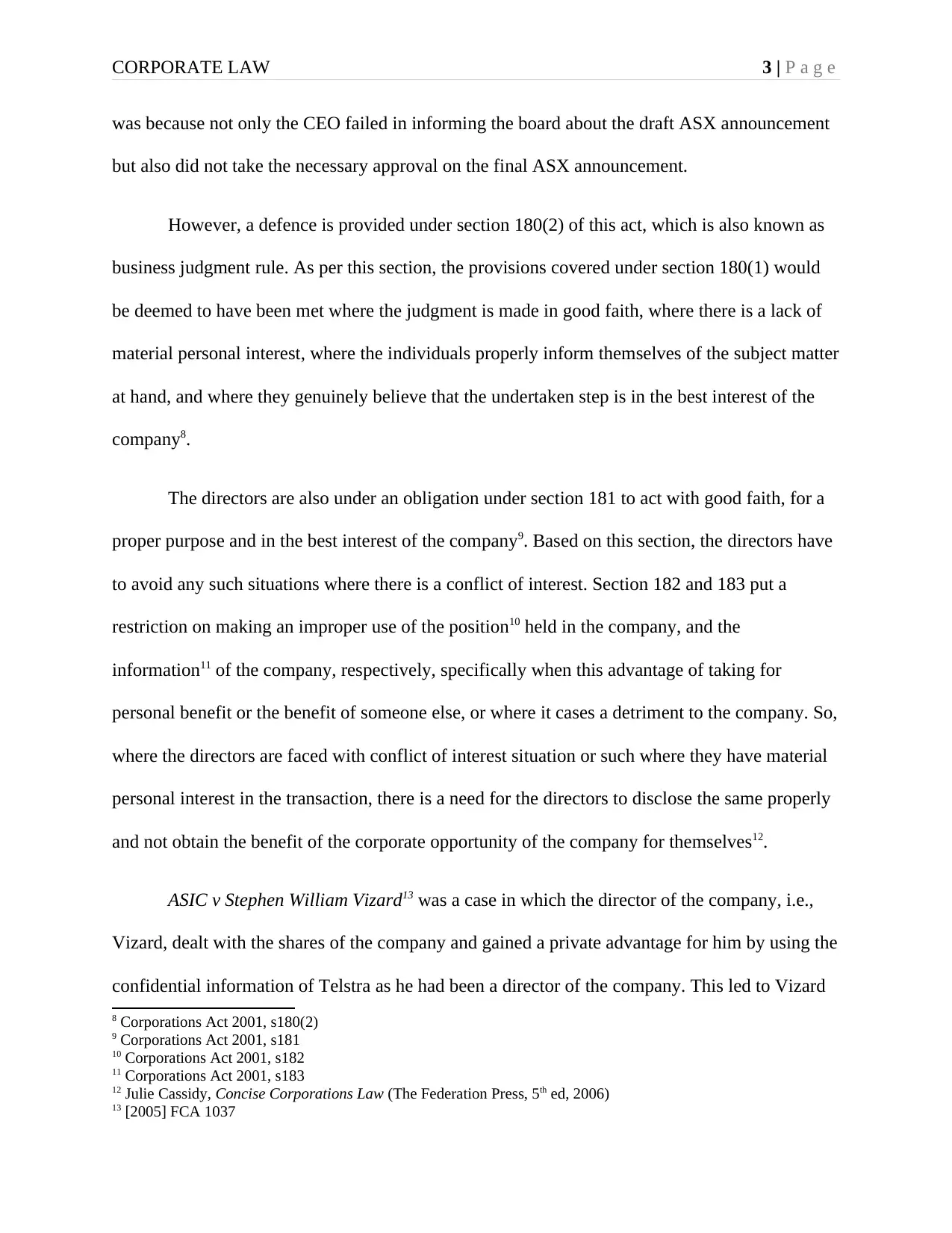
CORPORATE LAW 3 | P a g e
was because not only the CEO failed in informing the board about the draft ASX announcement
but also did not take the necessary approval on the final ASX announcement.
However, a defence is provided under section 180(2) of this act, which is also known as
business judgment rule. As per this section, the provisions covered under section 180(1) would
be deemed to have been met where the judgment is made in good faith, where there is a lack of
material personal interest, where the individuals properly inform themselves of the subject matter
at hand, and where they genuinely believe that the undertaken step is in the best interest of the
company8.
The directors are also under an obligation under section 181 to act with good faith, for a
proper purpose and in the best interest of the company9. Based on this section, the directors have
to avoid any such situations where there is a conflict of interest. Section 182 and 183 put a
restriction on making an improper use of the position10 held in the company, and the
information11 of the company, respectively, specifically when this advantage of taking for
personal benefit or the benefit of someone else, or where it cases a detriment to the company. So,
where the directors are faced with conflict of interest situation or such where they have material
personal interest in the transaction, there is a need for the directors to disclose the same properly
and not obtain the benefit of the corporate opportunity of the company for themselves12.
ASIC v Stephen William Vizard13 was a case in which the director of the company, i.e.,
Vizard, dealt with the shares of the company and gained a private advantage for him by using the
confidential information of Telstra as he had been a director of the company. This led to Vizard
8 Corporations Act 2001, s180(2)
9 Corporations Act 2001, s181
10 Corporations Act 2001, s182
11 Corporations Act 2001, s183
12 Julie Cassidy, Concise Corporations Law (The Federation Press, 5th ed, 2006)
13 [2005] FCA 1037
was because not only the CEO failed in informing the board about the draft ASX announcement
but also did not take the necessary approval on the final ASX announcement.
However, a defence is provided under section 180(2) of this act, which is also known as
business judgment rule. As per this section, the provisions covered under section 180(1) would
be deemed to have been met where the judgment is made in good faith, where there is a lack of
material personal interest, where the individuals properly inform themselves of the subject matter
at hand, and where they genuinely believe that the undertaken step is in the best interest of the
company8.
The directors are also under an obligation under section 181 to act with good faith, for a
proper purpose and in the best interest of the company9. Based on this section, the directors have
to avoid any such situations where there is a conflict of interest. Section 182 and 183 put a
restriction on making an improper use of the position10 held in the company, and the
information11 of the company, respectively, specifically when this advantage of taking for
personal benefit or the benefit of someone else, or where it cases a detriment to the company. So,
where the directors are faced with conflict of interest situation or such where they have material
personal interest in the transaction, there is a need for the directors to disclose the same properly
and not obtain the benefit of the corporate opportunity of the company for themselves12.
ASIC v Stephen William Vizard13 was a case in which the director of the company, i.e.,
Vizard, dealt with the shares of the company and gained a private advantage for him by using the
confidential information of Telstra as he had been a director of the company. This led to Vizard
8 Corporations Act 2001, s180(2)
9 Corporations Act 2001, s181
10 Corporations Act 2001, s182
11 Corporations Act 2001, s183
12 Julie Cassidy, Concise Corporations Law (The Federation Press, 5th ed, 2006)
13 [2005] FCA 1037
⊘ This is a preview!⊘
Do you want full access?
Subscribe today to unlock all pages.

Trusted by 1+ million students worldwide
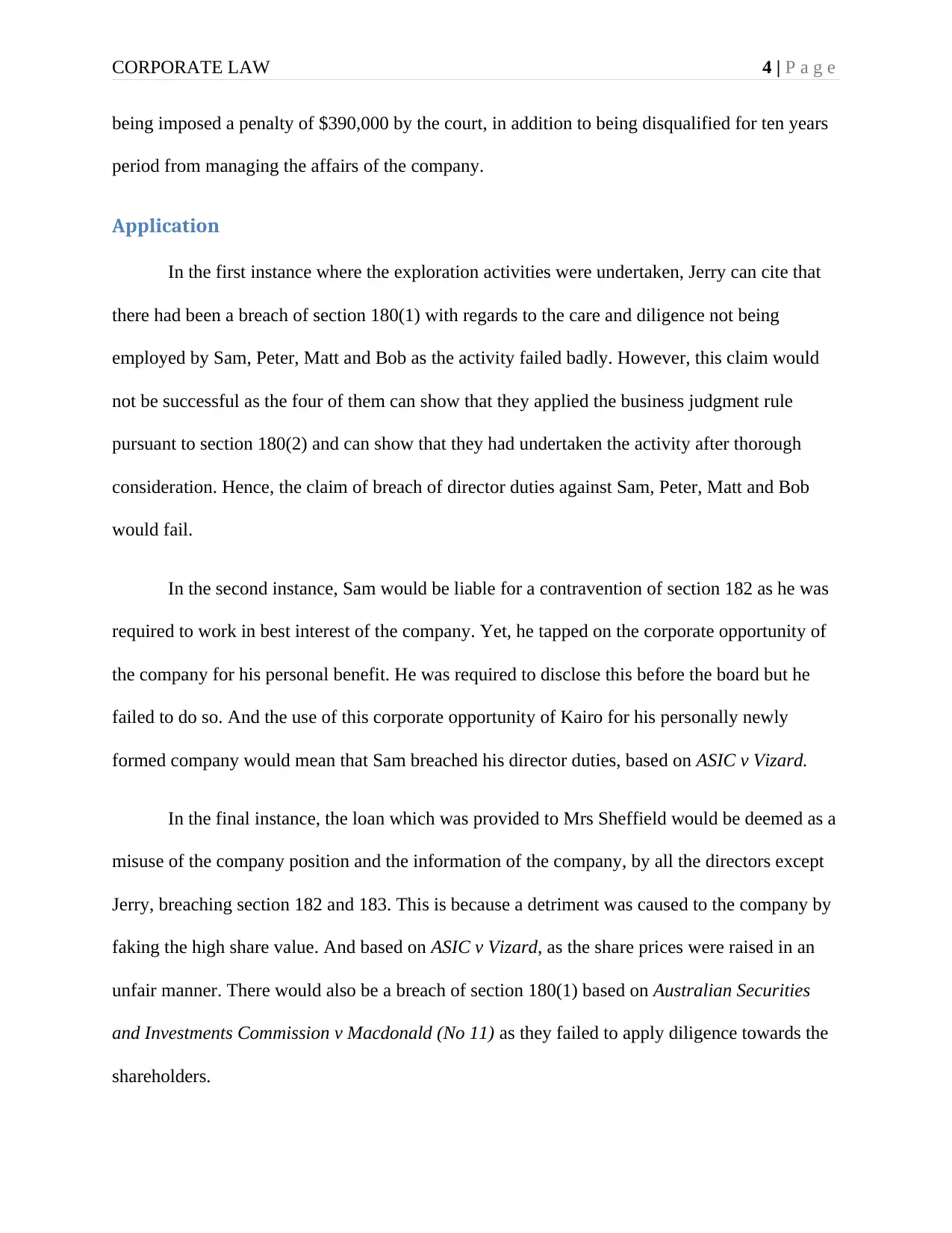
CORPORATE LAW 4 | P a g e
being imposed a penalty of $390,000 by the court, in addition to being disqualified for ten years
period from managing the affairs of the company.
Application
In the first instance where the exploration activities were undertaken, Jerry can cite that
there had been a breach of section 180(1) with regards to the care and diligence not being
employed by Sam, Peter, Matt and Bob as the activity failed badly. However, this claim would
not be successful as the four of them can show that they applied the business judgment rule
pursuant to section 180(2) and can show that they had undertaken the activity after thorough
consideration. Hence, the claim of breach of director duties against Sam, Peter, Matt and Bob
would fail.
In the second instance, Sam would be liable for a contravention of section 182 as he was
required to work in best interest of the company. Yet, he tapped on the corporate opportunity of
the company for his personal benefit. He was required to disclose this before the board but he
failed to do so. And the use of this corporate opportunity of Kairo for his personally newly
formed company would mean that Sam breached his director duties, based on ASIC v Vizard.
In the final instance, the loan which was provided to Mrs Sheffield would be deemed as a
misuse of the company position and the information of the company, by all the directors except
Jerry, breaching section 182 and 183. This is because a detriment was caused to the company by
faking the high share value. And based on ASIC v Vizard, as the share prices were raised in an
unfair manner. There would also be a breach of section 180(1) based on Australian Securities
and Investments Commission v Macdonald (No 11) as they failed to apply diligence towards the
shareholders.
being imposed a penalty of $390,000 by the court, in addition to being disqualified for ten years
period from managing the affairs of the company.
Application
In the first instance where the exploration activities were undertaken, Jerry can cite that
there had been a breach of section 180(1) with regards to the care and diligence not being
employed by Sam, Peter, Matt and Bob as the activity failed badly. However, this claim would
not be successful as the four of them can show that they applied the business judgment rule
pursuant to section 180(2) and can show that they had undertaken the activity after thorough
consideration. Hence, the claim of breach of director duties against Sam, Peter, Matt and Bob
would fail.
In the second instance, Sam would be liable for a contravention of section 182 as he was
required to work in best interest of the company. Yet, he tapped on the corporate opportunity of
the company for his personal benefit. He was required to disclose this before the board but he
failed to do so. And the use of this corporate opportunity of Kairo for his personally newly
formed company would mean that Sam breached his director duties, based on ASIC v Vizard.
In the final instance, the loan which was provided to Mrs Sheffield would be deemed as a
misuse of the company position and the information of the company, by all the directors except
Jerry, breaching section 182 and 183. This is because a detriment was caused to the company by
faking the high share value. And based on ASIC v Vizard, as the share prices were raised in an
unfair manner. There would also be a breach of section 180(1) based on Australian Securities
and Investments Commission v Macdonald (No 11) as they failed to apply diligence towards the
shareholders.
Paraphrase This Document
Need a fresh take? Get an instant paraphrase of this document with our AI Paraphraser
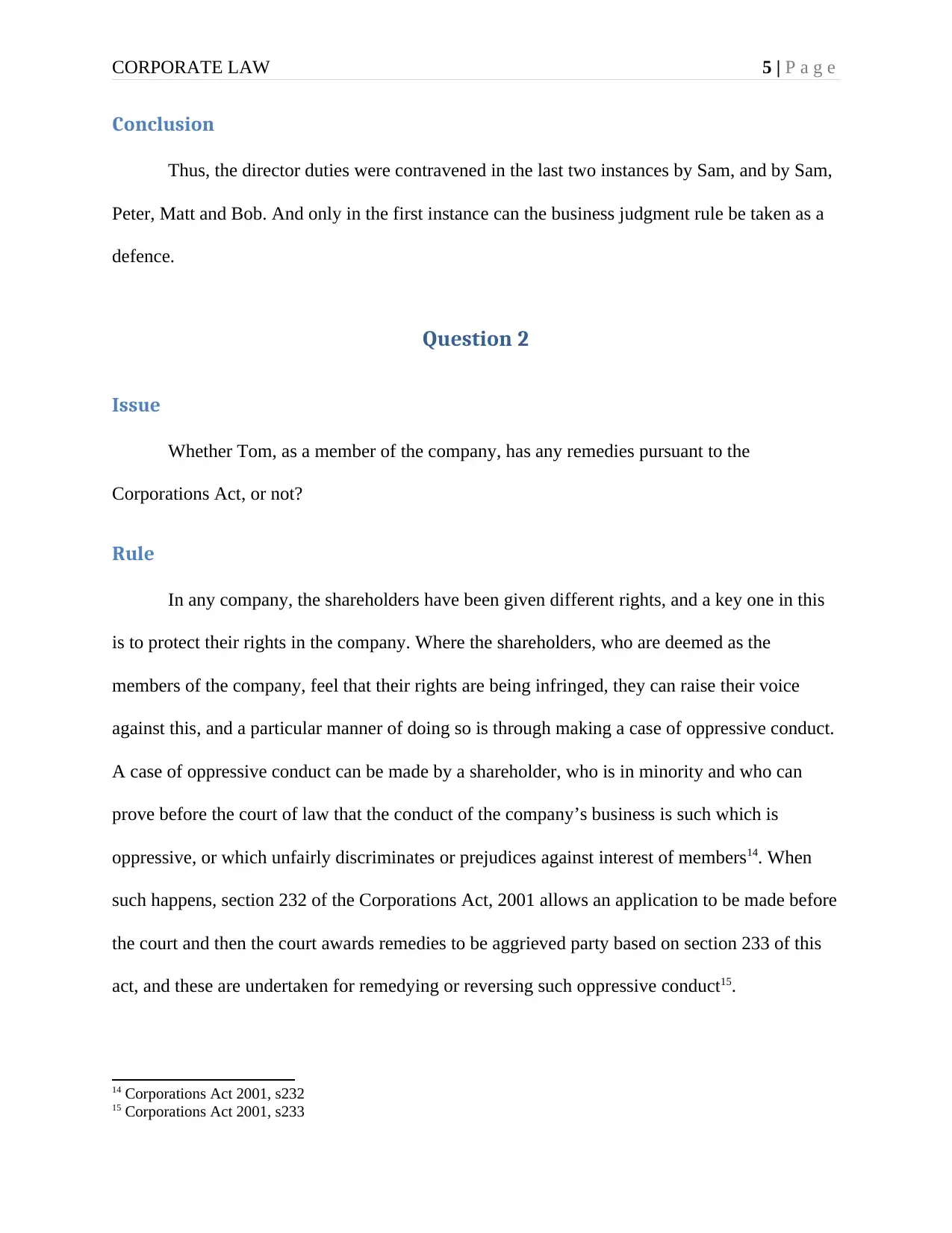
CORPORATE LAW 5 | P a g e
Conclusion
Thus, the director duties were contravened in the last two instances by Sam, and by Sam,
Peter, Matt and Bob. And only in the first instance can the business judgment rule be taken as a
defence.
Question 2
Issue
Whether Tom, as a member of the company, has any remedies pursuant to the
Corporations Act, or not?
Rule
In any company, the shareholders have been given different rights, and a key one in this
is to protect their rights in the company. Where the shareholders, who are deemed as the
members of the company, feel that their rights are being infringed, they can raise their voice
against this, and a particular manner of doing so is through making a case of oppressive conduct.
A case of oppressive conduct can be made by a shareholder, who is in minority and who can
prove before the court of law that the conduct of the company’s business is such which is
oppressive, or which unfairly discriminates or prejudices against interest of members14. When
such happens, section 232 of the Corporations Act, 2001 allows an application to be made before
the court and then the court awards remedies to be aggrieved party based on section 233 of this
act, and these are undertaken for remedying or reversing such oppressive conduct15.
14 Corporations Act 2001, s232
15 Corporations Act 2001, s233
Conclusion
Thus, the director duties were contravened in the last two instances by Sam, and by Sam,
Peter, Matt and Bob. And only in the first instance can the business judgment rule be taken as a
defence.
Question 2
Issue
Whether Tom, as a member of the company, has any remedies pursuant to the
Corporations Act, or not?
Rule
In any company, the shareholders have been given different rights, and a key one in this
is to protect their rights in the company. Where the shareholders, who are deemed as the
members of the company, feel that their rights are being infringed, they can raise their voice
against this, and a particular manner of doing so is through making a case of oppressive conduct.
A case of oppressive conduct can be made by a shareholder, who is in minority and who can
prove before the court of law that the conduct of the company’s business is such which is
oppressive, or which unfairly discriminates or prejudices against interest of members14. When
such happens, section 232 of the Corporations Act, 2001 allows an application to be made before
the court and then the court awards remedies to be aggrieved party based on section 233 of this
act, and these are undertaken for remedying or reversing such oppressive conduct15.
14 Corporations Act 2001, s232
15 Corporations Act 2001, s233

CORPORATE LAW 6 | P a g e
Section 233 of this act empowers the court to award different remedies where an
oppressive conduct is established. The court, pursuant to this section, can make a winding up
order for the company, can ask the directors to purchase the shares or ask the company to do so,
can regulate the affairs of the company, order something to be done or refrain the management
from doing something, amend the constitution of the company, stop an individual from making
explicit actions or behaviour, discontinue the proceedings, and authorize a person to transmit
shares by will or law16.
Thomas v H W Thomas Ltd17 was a case in which three conditions were put forward by
the court regarding a case of oppressive conduct to be upheld. It was stated that there was a need
to show that the objective of the undertaken conduct to result in unjustly prejudicial/
discriminatory or oppressive conduct; that the parties’ reasonable expectations were not met, and
that the awarding of remedy is a just thing to do in this matter.
Hillam v Ample Source International Ltd (No. 2)18 is a case in which the demeanour of
the board of directors was deemed as oppressive towards the minority shareholders and thus, the
court ordered the company to be wound up, and for the distribution of the sale proceedings from
the sale of company assets.
Application
In the given case study, Tom holds only 25% of the shares which makes him a minority
shareholder as the remaining shares are held by Dion and his son Tim. There has been oppressive
conduct undertaken against Tom, as the constitution has been amended where the purpose of the
company has been changed and even an ordinary resolution was passed were Dion and Tim
16 Corporations Act 2001, s233
17 (1984) 1 NZLR 686
18 (2012) FCAFC 73
Section 233 of this act empowers the court to award different remedies where an
oppressive conduct is established. The court, pursuant to this section, can make a winding up
order for the company, can ask the directors to purchase the shares or ask the company to do so,
can regulate the affairs of the company, order something to be done or refrain the management
from doing something, amend the constitution of the company, stop an individual from making
explicit actions or behaviour, discontinue the proceedings, and authorize a person to transmit
shares by will or law16.
Thomas v H W Thomas Ltd17 was a case in which three conditions were put forward by
the court regarding a case of oppressive conduct to be upheld. It was stated that there was a need
to show that the objective of the undertaken conduct to result in unjustly prejudicial/
discriminatory or oppressive conduct; that the parties’ reasonable expectations were not met, and
that the awarding of remedy is a just thing to do in this matter.
Hillam v Ample Source International Ltd (No. 2)18 is a case in which the demeanour of
the board of directors was deemed as oppressive towards the minority shareholders and thus, the
court ordered the company to be wound up, and for the distribution of the sale proceedings from
the sale of company assets.
Application
In the given case study, Tom holds only 25% of the shares which makes him a minority
shareholder as the remaining shares are held by Dion and his son Tim. There has been oppressive
conduct undertaken against Tom, as the constitution has been amended where the purpose of the
company has been changed and even an ordinary resolution was passed were Dion and Tim
16 Corporations Act 2001, s233
17 (1984) 1 NZLR 686
18 (2012) FCAFC 73
⊘ This is a preview!⊘
Do you want full access?
Subscribe today to unlock all pages.

Trusted by 1+ million students worldwide

CORPORATE LAW 7 | P a g e
decided to remove Tom from his director position. This oppressive conduct would allow Tom to
make an application to the court pursuant to section 232 as an oppressive conduct is present here.
The remedies should be awarded as based on Thomas v H W Thomas Ltd, the objective of this
oppressive conduct was to remove Tom from director position, so that he no longer raises his
voice against Dion and Tim; the reasonable expectations of being given an equal say in the
workings of the company was not given to Tom; and by awarding remedies to Tom, it’ll be just
and equitable. And on the basis of Hillam v Ample Source International Ltd, Tom can apply for
winding up of the company.
Conclusion
Hence, it can be concluded that Tom, as a member of the company, has remedies
pursuant to the Corporations Act, based on the oppressive conduct.
decided to remove Tom from his director position. This oppressive conduct would allow Tom to
make an application to the court pursuant to section 232 as an oppressive conduct is present here.
The remedies should be awarded as based on Thomas v H W Thomas Ltd, the objective of this
oppressive conduct was to remove Tom from director position, so that he no longer raises his
voice against Dion and Tim; the reasonable expectations of being given an equal say in the
workings of the company was not given to Tom; and by awarding remedies to Tom, it’ll be just
and equitable. And on the basis of Hillam v Ample Source International Ltd, Tom can apply for
winding up of the company.
Conclusion
Hence, it can be concluded that Tom, as a member of the company, has remedies
pursuant to the Corporations Act, based on the oppressive conduct.
Paraphrase This Document
Need a fresh take? Get an instant paraphrase of this document with our AI Paraphraser
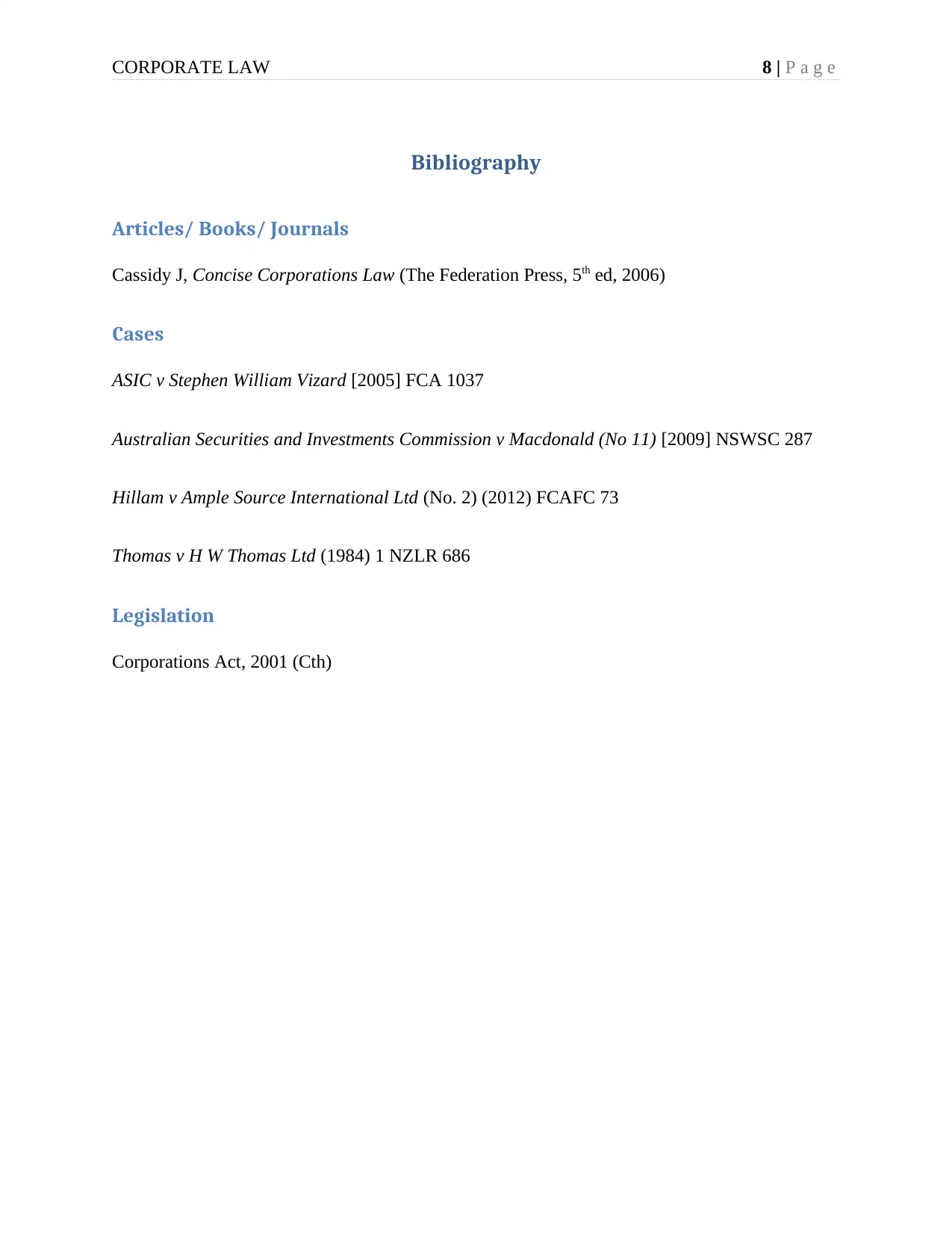
CORPORATE LAW 8 | P a g e
Bibliography
Articles/ Books/ Journals
Cassidy J, Concise Corporations Law (The Federation Press, 5th ed, 2006)
Cases
ASIC v Stephen William Vizard [2005] FCA 1037
Australian Securities and Investments Commission v Macdonald (No 11) [2009] NSWSC 287
Hillam v Ample Source International Ltd (No. 2) (2012) FCAFC 73
Thomas v H W Thomas Ltd (1984) 1 NZLR 686
Legislation
Corporations Act, 2001 (Cth)
Bibliography
Articles/ Books/ Journals
Cassidy J, Concise Corporations Law (The Federation Press, 5th ed, 2006)
Cases
ASIC v Stephen William Vizard [2005] FCA 1037
Australian Securities and Investments Commission v Macdonald (No 11) [2009] NSWSC 287
Hillam v Ample Source International Ltd (No. 2) (2012) FCAFC 73
Thomas v H W Thomas Ltd (1984) 1 NZLR 686
Legislation
Corporations Act, 2001 (Cth)
1 out of 8
Related Documents
Your All-in-One AI-Powered Toolkit for Academic Success.
+13062052269
info@desklib.com
Available 24*7 on WhatsApp / Email
![[object Object]](/_next/static/media/star-bottom.7253800d.svg)
Unlock your academic potential
Copyright © 2020–2025 A2Z Services. All Rights Reserved. Developed and managed by ZUCOL.



![Analysis of ASIC V. RICH [2003] Case on Corporations Act Section 180](/_next/image/?url=https%3A%2F%2Fdesklib.com%2Fmedia%2Fasic-rich-analysis-corporations-act_page_2.jpg&w=256&q=75)
![Detailed Case Study: ASIC v Narain [2008] FCAFC 120 - Corporations Law](/_next/image/?url=https%3A%2F%2Fdesklib.com%2Fmedia%2Fimages%2Fjp%2Fef194f4833aa4344888c1630d12f41be.jpg&w=256&q=75)
